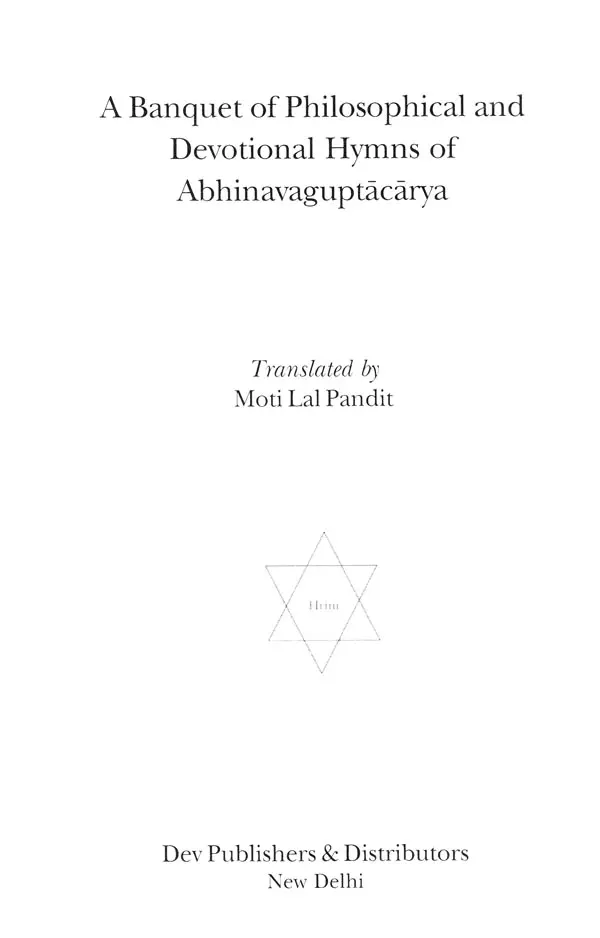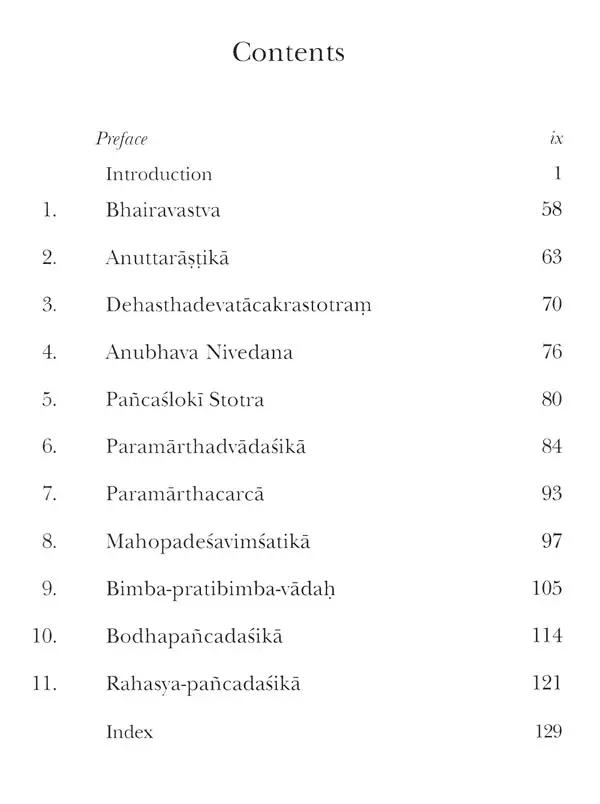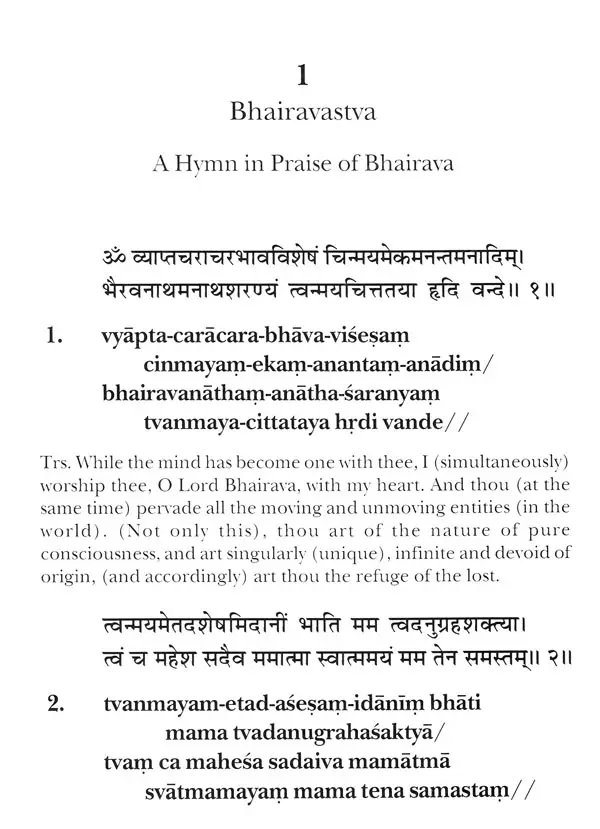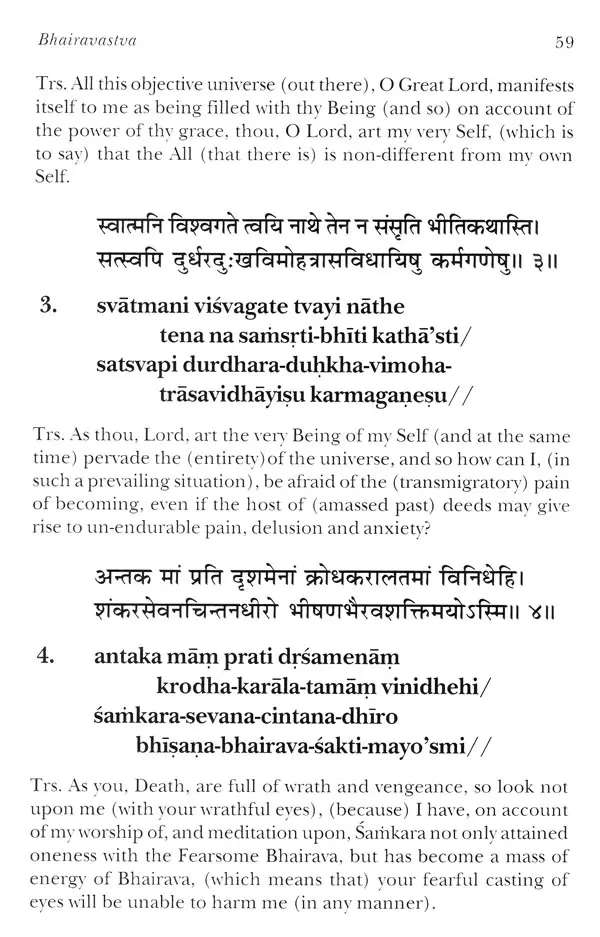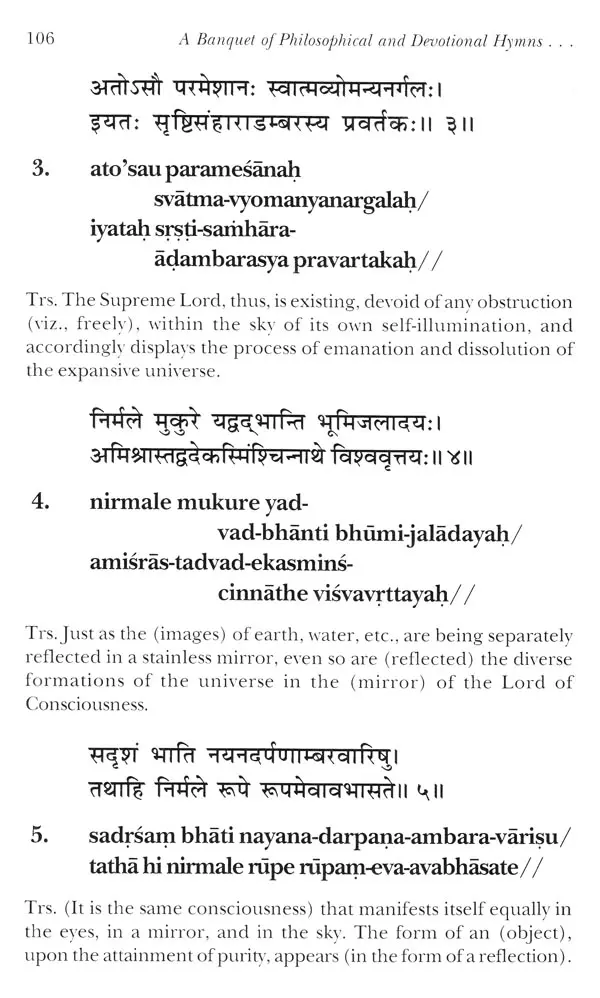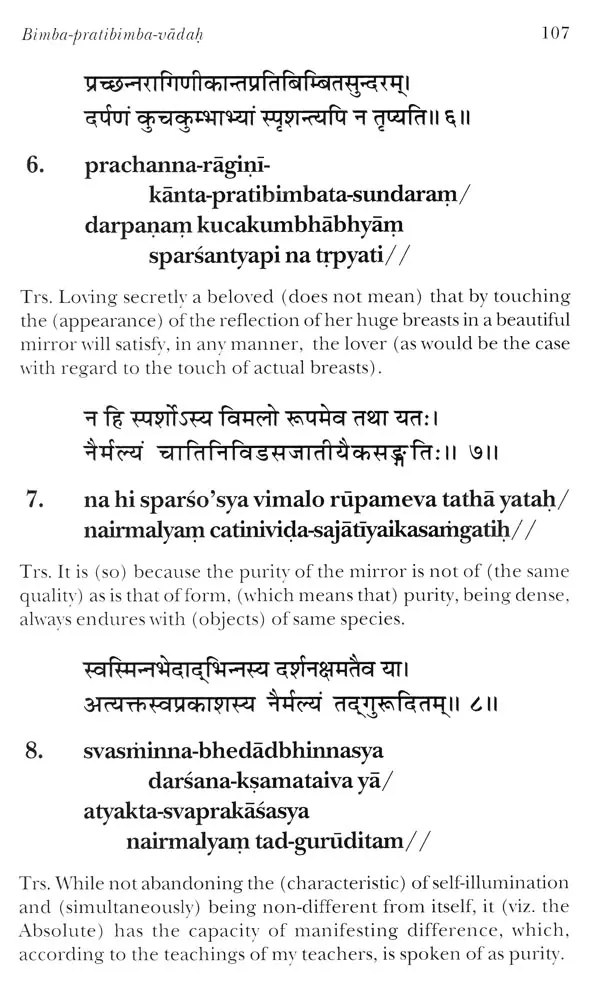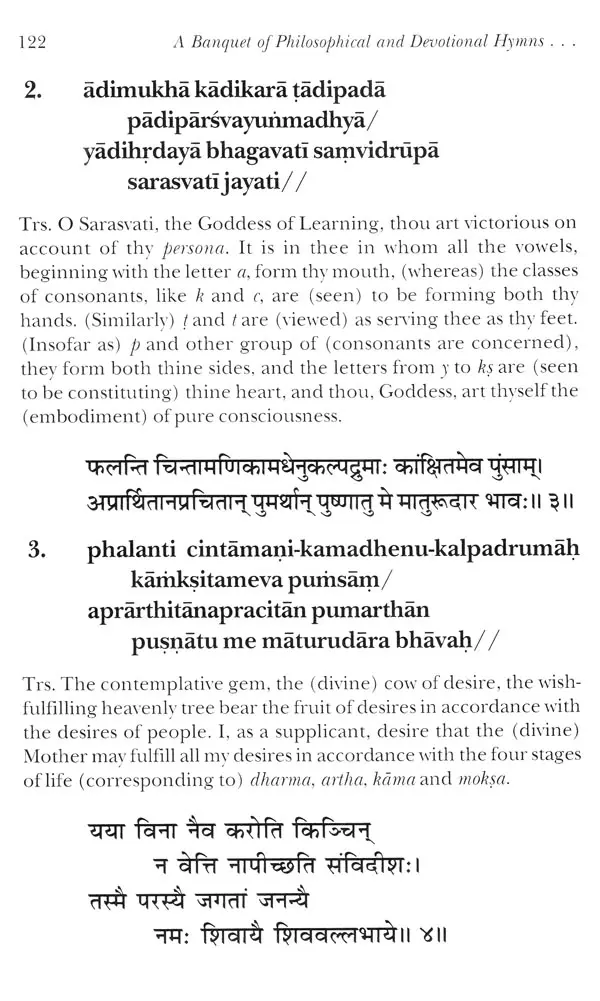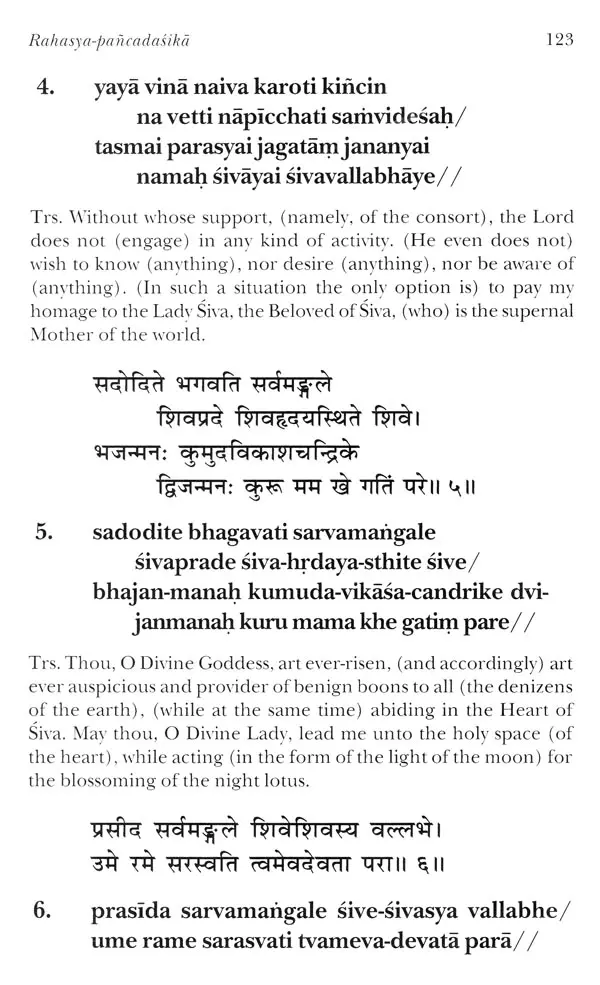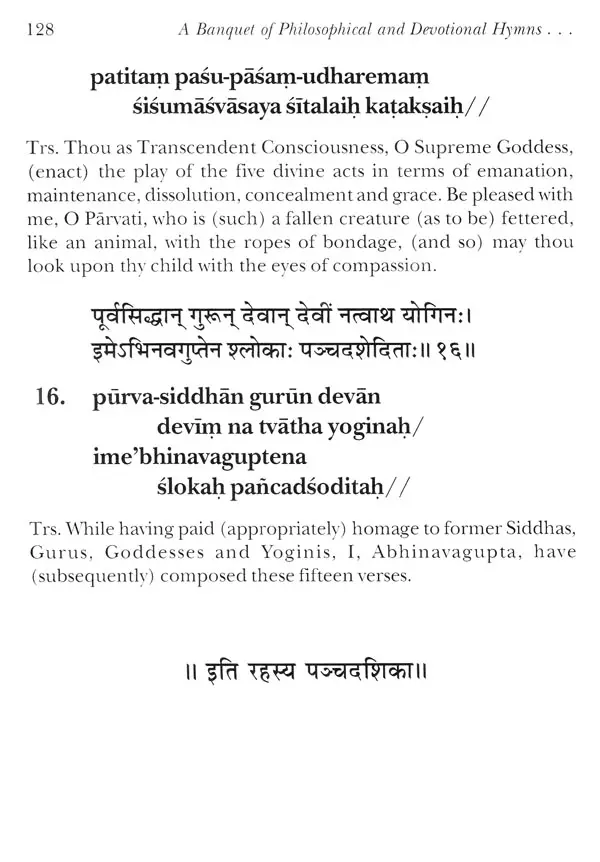
A Banquet of Philosophical and Devotional Hymns of Abhinavaguptacarya
Book Specification
| Item Code: | UBC860 |
| Author: | Moti Lal Pandit |
| Publisher: | Dev Publishers and Distributors |
| Language: | Sanskrit Text With Translieration and English Translation |
| Edition: | 2023 |
| ISBN: | 9789394852198 |
| Pages: | 147 |
| Cover: | HARDCOVER |
| Other Details | 9.00 X 6.00 inch |
| Weight | 320 gm |
Book Description
The collection of hymns of Abhinavagupta that have been translated, and are accordingly being presented to the public, represent such a diversity of thought of the composer of these hymns as would encompass the doctrinal, devotional and philosophical aspects of what has come to be known as the Shaivism of Kashmir. These hymns express the simplest mode of instruction in terms of which is conveyed the essence of non-dual spirituality that has been developed, both theoretically and devotionally, by the Siddhas and the accomplished Gurus of the Trika lineage. The thrust of this Trika spirituality, as expressed in these hymns, is to find out such ways and means as would lead to the transcedence of the profane by entering into the realm of the sacred. It is in terms of the entrance into the sacred that the profane structures of dualism are and thereby is allowed the flow of the theophany that terminates in the experience of the epiphany of deification. Such a state of divinity pulsates the very core of existence in such a manner as would allow the perception of divinity to occur. This realization a divinzation forms the core of these hymns, and so the entire universe is seen but the self- expression of Paramasiva. In the experiential state of non-difference is comented perfect unity in terms of which disappear all the conceptual differences which is the bane of empirical mode of life.
Moti Lal Pandit, trained as a theologian and linguist, has been engaged in Indological research nearly for last fifty yerars. He has published books and articles on a vast range of subjects. Initially he began his research in Vedic religion and philosophy. Gradually be shifted his attention towards Buddhism, and, as a result of this shift, he has been successful in publishing a number of books on Buddhist philosophy and history. For last several years, however, he has been engaged in the study of Kashmr Shaivism. Some of his publications are: Vedic Hinduism; Philosophy of the Upanishads; Essentials of Buddhist Thought; Samkara's Concept of Reality; Did Mare Kill God; Buddhism in Perspective; Being as Becoming Towards Transcendence; Transcendence and Negation: Snyata: The Essence of Mahayana Spirituality: Buddhism: A Religion of Salvation Encounter with Buddhism; The Buddhist Theory of Knowledge and Reality: The Trika Shainism of Kashmir; The Disclosure of Being; An Introduction to the Philosophy of Trika Shaivism; The Philosophical and Practical Aspects of Kashmir Shaivism; From Dualism to Non-dualism; The Transcendental Non- Dualism of Trika Shaivism; (trs.) The Essence of Supreme Reality, or The Paramarthasara of Abbinanggupta, and (trans.) The Kramastotra of Siddhanatha.
The collection of hymns of Abhinavagupta that have been translated, and are accordingly being presented to the public. represent such diversity of thought of the composer of these hymns as would encompass the doctrinal, devotional and philosophical aspects of what has come to be known as the Trika Shaivism of Kashmir. These hymns express the simplest mode of instruction in terms of which is conveyed the essence of spirituality that has been developed, both theoretically and devotionally, by the Siddhas of the Trika lineage. Let us take into consideration some of the hymns and find out as to how the essence of Trika thought and devotional mysticism is communicated. In the hymn, called the Bhairava Stva, or The Hymn in Praise of Bhairava, the depth of spirituality that is expressed in it has its roots in the personal experience of Abhinavagupta, and in terms of which a clear demarcating line is drawn between the Sacred and the Profane. Having attained the perfect immersion (somaveśa) in terms of "entrance" into the Absolute, represented here by Bhairava, Abhinava accordingly explains the profundity of experience in terms of transcendence of finitude. Finitude, in all its forms, represents death, and is equated to the horrid desert that is devoid of green vegetation and life-giving water. Since finitude has been transcended, there accordingly eventuates the experience of the Absolute as being consciousness-bliss (cidananda). Thus every aspect of objectivity is experienced as being filled by the all-pervading universal consciousness. As a consequence of this experience the gap between "I" and "this" is bridged in terms of unitary consciousness. Likewise in the Anuttarastika brief outline is formulated in terms of which is explained the nature of non-dual spirituality, which is so characterized as to be, in equal measure, free from both attachmentand non-attachment. Instead of getting attached to objectivity or attempting to release oneself forcibly from attachment, one is advised to abide in one's Self in such a manner as to have the experience of perfect contentment. Equally are we advised that in the absolute non-dual state the sense of duality completely vanishes, which results in the coalescence of the worship, the worshipper and the worshipped into what may be called the experience of the unity of the essential nature. The experience of the non-dual illuminative consciousness is like the recovery of the long-forgotten treasure. However, there is a tendency among the worldly people of imposing an illusory snake on a real rope, or taking one's own shadow as being a ghost. Even though an unreal snake may have been imposed upon the rope, yet the fact remains that rope never becomes a snake. Likewise whatever differentiating interpretations may be offered with regard to the non-dual Absolute, it makes no difference insofar as the essential nature of Being is concerned. Such erroneous perception occurs on account of ignorance, which expresses itself in terms of considering the unreal as the real.
In contrast to the Great Tradition, the Trika Shaivas, while following in the footsteps of Tantricism, adhere to such a doctrinal viewpoint which considers the manifest objectivity as being nothing else than the congealed form of supreme consciousness (parasamvid), which, theologically speaking, is equated to Paramashiva. This viewpoint delineates the idea that materiality as such is divine precisely because it vibrates with the throb of divine consciousness. Applying this principle onto the human body. the Trika Shaivas thereby arrive at the conclusion that considers the human body as being the epitome of divinity itself, and accordingly the human body is seen to be containing within itself such divine forces which have to be invoked through the ritual of "placing of hands" (nyasa) at various locations of the body. This doctrinal aspect concerning the divinity of the body is explained through the Dehasthadevatacakra Stotram. Accordingly we are informed that the body, being the temple of divinity, needs to be so worshipped as would result in the worship of the eternal Deity, namely, the Self, which is within the body. This hymn represents the philosophical outlook concerning the body as being divine of such lineages as the Krama and Kaula.
It is rare to find a thinker whose biographical sketches are clear to us. Abhinavagupta stands out as a solitaire amongst the gems of thinkers precisely because he outshines all the others the brilliance of detail that he has provided to us about his life and times. The philosophical outlook that he has developed through his valuable commentaries does not merely impart to us the information concerning the nature of abstract forms of thought, but possess such brilliance of his thought as would outshine so many brilliant scholarly works and philosophies known to humankind. It is the intention of the author, through this brief work, to present to everyone the biographical sketches of Abhinavagupta in such a manner as would enthrall and inspire the heart of the reader by taking into cognizance that such a unique and outstanding thinker, aesthetician, and, above all, a yogi ever existed upon this earth.
Abhinava himself tells us, through various of his compositions, that his earliest ancestor, Atrigupta, was a great Saivite scholar and is said to have lived in Kannauj during the reign of Yasovarman (730 cz-740 cz). Atrigupta is said to have attained great fame on account of his deep and scholarly knowledge concerning the existing branches of learning. Apart from his scholarship in the various fields of knowledge, he is said to have been one of the leading authorities concerning the Saiva scriptures of all the denominations. At that time Kannauj was ruled by Yasovarman who was eventually defeated by Lalitäditya - the King of Kashmir. Lalitäditya was a great admirer of learning and scholarship, and on hearing that there lived a great scholar called Atrigupta, he was accordingly greatly impressed by the scholarly crudition of Atrigupta, and so he desired that it would be appropriate for the scholar to settle in the Valley of Kashmir in order that the local populace may greatly benefit from his scholarship. Accordingly, the king extended his invitation to Atrigupta to settle in Kashmir.. The invitation was duly accepted, and Atrigupta accompanied the king to Kashmir, along with his family, leaving Kanyakubja behind. Atrigupta, upon reaching Kashmir, was provided with a spacious house on the banks of Vitasta, opposite to Sitamsumalin temple. For the maintenance of the household, a large jägir was granted to Atrigupta. For next two centuries we know nothing as to who were the people who succeeded the lineage founded by Atrigupta till the time of Varáhagupta, the grandfather of Abhinavagupta, who may have lived during the beginning of 10 century.
**Contents and Sample Pages**
